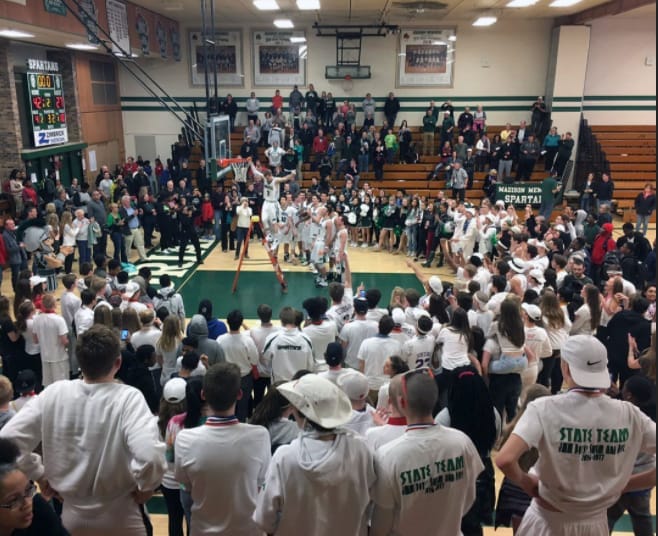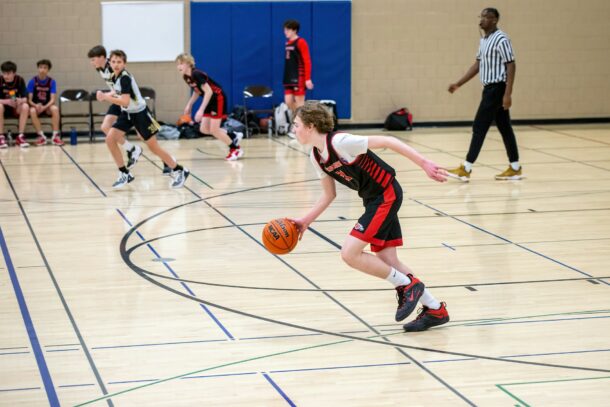In today’s game, data, analytics, and AI are reshaping how coaches prepare and how players develop. But true progress isn’t about replacing coaches with technology, it’s about using tools to strengthen how we teach and connect. That’s where The Coaching Habit comes in. By pairing its simple framework with AI-backed basketball coaching strategies, you can build smarter players, stronger leaders, and a team culture that thrives on curiosity and accountability.
1. Stay Curious Longer
Instead of jumping in with “Run this set” or “Do this drill,” lead with curiosity. Ask questions before giving instructions.
- Ask first, tell later.
- Let players explain what they saw.
- Build basketball IQ by giving them space to think.
On-court prompt:
“What did you see? And what else? What’s the real challenge here for you on that coverage?”
When you lead with questions, you shift players from order-takers to decision-makers, an essential part of modern, AI-backed basketball coaching strategies.
2. Find the Real Problem, Not the First Miss
A missed layup is often a symptom, not the root issue.
- Was the angle off?
- Did they misread pace or spacing?
- Was contact the culprit?
Stick with one issue until it’s clear, instead of piling on five quick fixes. Probe:
“Of all the things here, what’s the real challenge for you finishing through contact?”
3. Coach for Autonomy
When players own their choices, they grow faster.
- Ask for their ideas before giving yours: “Give me two ways you can guard that horn set.”
- Use the “Lazy Question”: “How can I help?”
The real success metric: players begin self-correcting mid-possession, no coach voice needed. This type of autonomy is central to AI-backed basketball coaching strategies, where insights meet self-led adjustments.
4. Be Strategic with Time & Energy
Coaching is a finite resource. Use it wisely.
- Strategic Question: “If we say yes to more transition, what are we saying no to in half-court touches?”
- Keep micro-coaching to 1–3 questions, then get back to reps.
- Use short film segments (10 minutes), focused on one theme, one cue, one behavior.
5. Make Coaching a Habit
Turn your best questions into daily rituals.
- Daily loop closer: “What was most useful for you today, and what will you try tomorrow?”
- Make it team culture that players ask each other first, then bring the coach in.
The habit isn’t answering. The habit is asking.
Join the TeachHoops Community

TeachHoops.com offers a unique platform for coaches to share experiences and gain new insights. Learn from others who have navigated similar challenges. It’s an invaluable resource for those looking to:
- Broaden perspectives
- Refine strategies
- Enhance their leadership and motivational skills
Step into Enhanced Coaching
Win the Season: Basketball Masterclass!

Pocket Scripts You Can Use (Or Adapt with AI Insight)
Sometimes coaches need ready-made prompts they can pull out on the fly. These “pocket scripts” keep your questions sharp and consistent, whether you’re in the middle of a drill, dealing with a slump, or breaking down film.
After a defensive breakdown:
“What did you see?” → “And what else?” → “What’s the real challenge for you on that switch?” → “How can I help?” → “What was most useful?”
Shooting slump:
“What do you want on your next two shots?” → “If yes to quicker release, what are you saying no to?” → “What was most useful from that sequence?”
Film review:
“What’s on your mind from Q3?” → “And what else?” → “What’s the real challenge for you vs. #24?” → “What’s one adjustment you’ll own next game?”
Player-Led Huddle Checklist
If you want players to lead from within, give them a clear framework. This checklist turns a huddle into a space where athletes drive the dialogue, while coaches step back and listen.
- What’s on your mind?
- And what else?
- Real challenge for you?
- What do you want?
- How can I/teammates help?
- If yes to X, what are you saying no to?
- What was most useful?
The AI Connection: Coaching Habit + Smart Tools
Pairing The Coaching Habit with modern technology gives coaches a powerful edge. AI tools like video analysis, shot-tracking software, and player workload monitors can identify patterns or hidden weaknesses. But questions keep the learning personal.
- AI highlights the “what” (e.g., shot release speed slowed in the 4th quarter).
- The Coaching Habit digs into the “why” (mental fatigue? defensive pressure?).
The two together form AI-backed basketball coaching strategies that are both data-driven and player-centered.
Conclusion
If your goal is to create players who think, adapt, and lead, adopting The Coaching Habit is essential. By blending this framework with AI-backed basketball coaching strategies, you give your athletes the tools to self-correct, stay engaged, and grow into leaders on and off the floor.
Latest Posts
- How AI Coaching Prompts Can Transform Your Youth Basketball Program
- AI-Backed Basketball Coaching Strategies: Why Coaches and Players Should Adopt ‘The Coaching Habit’
- AI Tools for Basketball Coaches: Saving Time and Improving Your Program
- Complete Offseason Basketball Workout for Youth Players
- The Best Youth Basketball Passing Drills Every Coach Should Know





